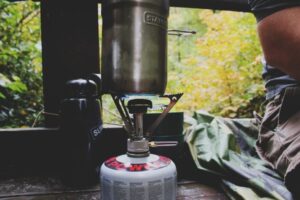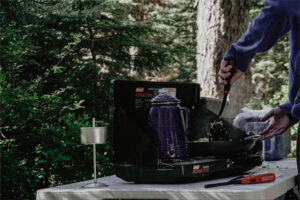
Let’s learn how to use your gear! Practice setting up your tent, master water purification techniques, and familiarize yourself with basic survival skills like fire-starting. When you know what you’re doing, the wilderness doesn’t feel so wild anymore.
What is Overnight Hiking?
Backpacking, or overnight hiking, is essentially camping while on a hiking trail. It involves carrying all your necessary gear (shelter, food, water, sleep system, etc.) on your back and hiking to a designated campsite or suitable location where you spend the night and then continuing your hike the next day, or even longer.
What to Need
- Choosing a route:You pick a trail suitable for overnight hiking, considering factors like distance, difficulty, terrain, and availability of campsites.
- Packing your backpack:You need to pack efficiently, prioritizing essential items like shelter, sleeping bag, sleeping pad, food, water, cooking gear (optional), navigation tools, first-aid kit, headlamp, and warm clothing. Remember, you’ll be carrying everything on your back!
- Learning essential skills:knowing how to set up your tent, use a map and compass, navigate with GPS, prepare meals outdoors, treat water, and leave no trace are crucial for a safe and enjoyable overnight hike.
Benefits
- Deeper connection with nature:Spending more time immersed in the natural world provides a deeper appreciation for its beauty and challenges.
- Physical and mental challenge:Overnight hiking pushes your physical limits and tests your mental resilience, offering a sense of accomplishment and personal growth.
- Unique experiences:Camping under the stars, witnessing incredible sunrises from mountaintops, and encountering wildlife are unforgettable memories made on overnight hikes.
- Living minimally:You learn to appreciate the essentials and simplify your needs. Carrying and using what you pack teaches resourcefulness and self-reliance.
What to Pack for Overnight Hike
Camping Gear
- Backpack
- Pack rain cover
- Sleeping shelter (bivvy, tent, or hammock)
- Sleeping bag
- Sleeping pad
- Headlamp and batteries
- Optional: Tent footprint or tarp
Camp Kitchen
- Backpacking stove
- Fuel
- Cooking pot
- Eating/Cooking utensils
- Mug & water container
- Water purifier
- Biodegradable soap
- Microfiber cloth
- Food
- Bear canister (if needed)
Clothing Essentials
- Underwear
- Synthetic or wool socks
- T-shirt
- Long-sleeve shirt
- Light jacket
- Shorts or pants
- Shoes appropriate for terrain
- Sun hat/glasses *All clothing should be moisture-wicking and appropriate for the climate. Layering is advised. Do not wear cotton.
Personal Hygiene
- Toothbrush, toothpaste, and floss
- Hand sanitizer
- Trowel or wag bag
- TP/Wipes with bag to pack it out
- Menstrual items
- Prescription medications
- Lip balm
Emergency Kit/Other
- Sunscreen
- Bug repellent
- First aid kit
- Navigation (maps, compass, GPS)
- Whistle
- Waterproof matches & firestarter
- Multitool
- Knife
- Repair kit (duct tape, needle, thread, etc.)
- Itinerary with emergency contact and in-car
Optional Items
- Trekking poles
- Camera
- Smartphone
- Battery charger
- Journal & pen
- Apps: Star charts, navigation, bird and plant ID
- Backpacking chair
- Organizational bags or stuff sacks
- Paracord
How to Pack Strategically
Efficient packing is an art form that maximizes space and minimizes weight. Utilize compression sacks, stuff sacks, and packing cubes to organize gear systematically within your backpack. Distribute weight evenly to maintain balance and stability while hiking.
Layering your pack
· Bottom compartment
Pack bulky but light items like your sleeping bag, sleeping pad, and any extra layers you won’t need during the hike.
· Central compartment
Place heavier items like food, water reservoir, cook kit (optional), and your tent poles. This helps balance your pack weight.
· Top compartment
Keep easily accessible items like snacks, rain gear, first-aid kit, headlamp, map, sunscreen, and your phone.
· Hip Belt pockets
Stash essentials you’ll need on the trail like sunglasses, compass, and hand sanitizer.
Minimize weight and bulk
· Choose lightweight gear
Invest in a good backpack, tent, sleeping bag, and mat that are specifically designed for backpacking. Opt for synthetic or merino wool clothing over cotton, as they dry faster and stay warm even when wet.
· Multi-functional gear
Look for items that serve multiple purposes, like a spork-knife combo or a bandana that can be used as a sweatband or dust mask.
· Decant liquids
Transfer toiletries and lotions to reusable travel containers instead of bulky original packaging.
· Leave some at home
Consider using disposable camp towels instead of bulky bath towels, and be honest about what you truly need versus what you “might” use.
Organize for efficiency
· Use packing cubes
Group similar items like clothing, toiletries, and cooking gear into different cubes for easy access and compartmentalization.
· Label everything
Clearly label your cubes and any storage bags to save time rummaging.
· Double-check essentials
Make sure you haven’t forgotten the “Ten Essentials” of backpacking: navigation, headlamp, sun protection, insulation, first-aid kit, fire starter, repair kit, nutrition, hydration, and emergency shelter.
Weather and terrain specific
· Pack for the forecast
Adjust your clothing and gear based on expected weather conditions. Don’t forget layers for changing temperatures, rain gear, and appropriate footwear for the terrain.
· Consider the destination
Research the campsite availability and amenities on your chosen trail. If water isn’t readily available, you’ll need to carry purification tablets or filters.
Practice makes perfect
· Pack your bag at home
Lay everything out before your trip to ensure you haven’t missed anything and adjust weight distribution in your pack.
· Take a practice hike
If it’s your first time, test your packed backpack on a short day hike to identify any discomfort or adjustments needed.
Frequently Asked Questions
What should I sleep in on an overnight hike?
Choose a lightweight, compact sleeping bag appropriate for the climate and terrain. Consider layering clothing for added warmth if temperatures drop during the night.
What do I need for overnight backpacking?
Essential gear includes shelter (tent or hammock), sleeping bag, sleeping pad, navigation tools, lighting, first aid kit, and sufficient food and water supplies.
What do you wear overnight hiking?
Opt for moisture-wicking clothing layers, durable pants, sturdy hiking boots, and a waterproof jacket. Pack extra socks and consider layering for versatility in changing weather conditions.
How do I prepare for an overnight walk?
Research the trail conditions and terrain beforehand. Pack essential gear, including navigation tools, shelter, sleeping gear, and adequate food and water supplies. Familiarize yourself with emergency procedures and leave a detailed itinerary with a trusted contact.





